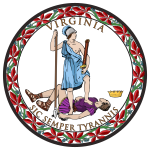 | ||||||||||||||
| ||||||||||||||
106 electoral votes of the Virginia Convention 54 electoral votes needed to win | ||||||||||||||
|---|---|---|---|---|---|---|---|---|---|---|---|---|---|---|
| ||||||||||||||
| ||||||||||||||
| Elections in Virginia |
|---|
 |
The Virginia gubernatorial election of 1776 was the first gubernatorial election of the newly independent Commonwealth of Virginia. It was held on June 29, 1776, forty-five days after the adoption of the Lee Resolution by the Fifth Virginia Convention asserting the independence of the United Colonies from Great Britain. The election was conducted under the provisions of the Constitution of Virginia, which had been adopted by the convention the same day and went into effect immediately. Patrick Henry, a leading advocate for independence who had served as a delegate to the First Continental Congress, was elected governor by a majority vote, defeating Thomas Nelson Jr. and John Page.
The new Constitution called for the Governor of Virginia to be elected by the votes of the Virginia General Assembly meeting in joint session. The Virginia Convention, as the provisional legislature of the commonwealth, performed this function in the election of 1776. Prior to 1830, the governor served a term of one year, renewable no more than three times in a seven-year period. Henry was reelected four times: twice consecutively in 1777 and 1778, and again in 1784 and 1785, to serve a total of five consecutive terms in office.[1]
YouTube Encyclopedic
-
1/5Views:37547230 1581 1148 565
-
Millions of Messages: Processing Gubernatorial E-mail at the Library of Virginia
-
Principles of the American Constitution, 1776-1787 (Advanced Session)
-
Thomas Jefferson | Claiming Independence | Biography
-
Voting Rights and Voter Suppression - Election 2020: UC Berkeley Big Ideas
-
Joerg Knipprath | Richard Henry Lee of VA: Author of the Resolution That Led to the Declaration
Transcription
Background
The Fifth Virginia Convention convened in Williamsburg on May 6, 1776, amidst increasingly widespread support for independence among the Patriots who supported the American Revolution. On May 15, 1776, the convention approved a resolution instructing Virginia's delegates in the Second Continental Congress to support a formal declaration of independence absolving the Thirteen Colonies from their allegiance to the British Empire. Congress voted to adopt the Lee Resolution on July 2, precipitating passage of the United States Declaration of Independence.[2][3]
While Congress debated independence, the Virginia Convention took action to establish the foundations for an independent commonwealth. A Declaration of Rights was introduced in the convention on May 27 and adopted on June 12; on June 29, the delegates voted unanimously to adopt the proposed Constitution of Virginia.[4] With the Constitution now in place, elections for governor and Attorney General proceeded immediately.
Electoral system
The Constitution of 1776 called for the governor and other executive officers to be elected by a joint session of the General Assembly, with a majority of votes cast necessary to elect the governor. The governor was elected for a term of one year and limited to three terms in a seven-year period. With the first General Assembly yet unelected, the Virginia Convention carried out the election of the first governor and Attorney General.[5] The election was conducted by secret ballot; in all, 106 delegates to the Virginia Convention cast votes for governor.[6]
Results
The Virginia Convention elected Henry by a majority of 60 electoral votes to 45 for his nearest competitor, Thomas Nelson. George Wythe, James Madison, Bartholomew Dandridge, and William Roscoe Wilson Curl were appointed to inspect the ballots and inform Henry of his election.[7]
| Gubernatorial candidate | Party | Electoral vote | |
|---|---|---|---|
| Count | Percentage | ||
| Patrick Henry | Nonpartisan | 60 | 56.60 |
| Thomas Nelson Jr. | Nonpartisan | 45 | 42.45 |
| John Page | Nonpartisan | 1 | 0.94 |
| Total | 106 | 100.00 | |
References
- ^ "Patrick Henry (1736–1799)". Encyclopedia Virginia. Archived from the original on October 30, 2013. Retrieved February 10, 2019.
- ^ W.F. Dunaway (1904). "The Virginia Conventions of the Revolution". The Virginia Law Register. 10 (7): 582. doi:10.2307/1100650. JSTOR 1100650.
- ^ Samuel Eliot Morison, Henry Steele Commager, and William E. Leuchtenburg, (1969). The Growth of the American Republic, Vol. 1, Sixth Edition, p. 172
- ^ Dunaway (1904)
- ^ Dunaway (1904)
- ^ J.N. Brenaman (1902). A History of Virginia Conventions. J. L. Hill printing Company. p. 36. Retrieved February 10, 2019.
virginia convention annals 1776.
- ^ Brenaman (1902)
- ^ Dunaway (1904) p. 585
- ^ Brenaman (1902) p. 37


